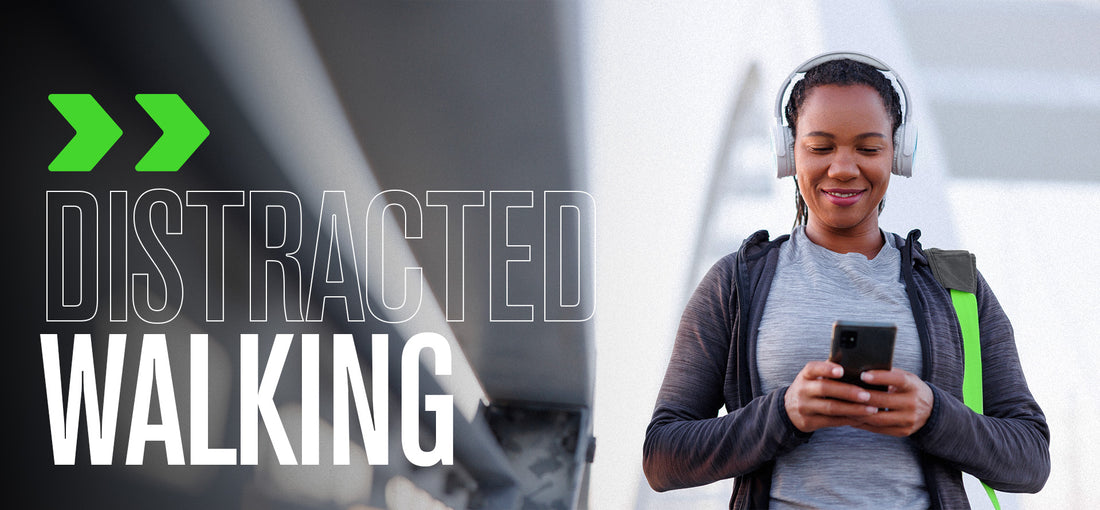In today's fast-paced world, where multitasking and cell phone distractions have become second nature, distracted walking has emerged as a significant public safety concern. As pedestrian traffic increases, the risks associated with distracted pedestrians are climbing at an alarming rate. By exploring the statistics and safety implications of distracted walking accidents, we aim to highlight the growing issue and offer practical measures to enhance pedestrian safety.
Understanding Distracted Walking
Distracted walking, like distracted driving, involves activities that divert a person's attention from their primary task of navigating safely. While distracted driving has long been recognized as a hazardous behavior, distracted walking is gaining attention due to the widespread use of mobile devices. Distracted pedestrians are often engaged in conversation with their walking partner or absorbed in their cell phones, whether texting, browsing, or listening to music, and they often lose awareness of their surroundings.
This lack of attention can lead to missed traffic signals, unseen obstacles, or failure to notice oncoming vehicles, creating potentially dangerous situations. Just as drivers are urged to keep their eyes on the road, pedestrians must stay alert and aware while walking, especially in urban areas where the interaction with vehicular traffic is frequent. By understanding the similarities between distracted walking and driving, we can better appreciate the importance of maintaining focus and minimizing cell phone distractions to ensure personal safety and the safety of others around us.
Distracted Walking Statistics
Distracted walking has become increasingly concerning, with statistics highlighting its impact on public safety. In a study monitoring the crossing behaviors of 1,102 pedestrians at various intersections in Seattle, Washington, distractions were noted in roughly 30% of the pedestrians, including listening to music (11.2%), text messaging (7.3%), and using a handheld phone (6.2%).
The National Safety Council is dedicated to eradicating distracted walking, particularly the type that involves using a mobile device while walking. Distracted pedestrians are often unaware of the risks associated with distracted walking and believe they can multitask. In a survey by Safe Kids Worldwide, half of the teens they interviewed said they used a cell phone while crossing the street, as highlighted in this video from Safe Kids Worldwide.
Another study conducted by The Ohio State University in 2013 revealed a significant rise in injuries linked to cell phone use among pedestrians in public places. Analyzing data from 100 emergency rooms across the country, the study noted that incidents had more than doubled from 2005 to 2010, reaching over 1,500 cases. The findings highlighted that individuals aged 16 to 25 were the most susceptible to accidents while distracted by their cell phones or other devices.
According to the National Highway Traffic Safety Administration, pedestrian deaths and accidents remain high. In 2022, 7,522 pedestrians were killed, and more than 67,000 pedestrians were injured nationwide. In 2024, it's crucial to monitor these trends and work towards reducing these preventable accidents, ensuring safer streets for everyone.
Consequences of Distracted Walking
Distracted walking, especially when it involves mobile devices, carries significant risks. Distracted pedestrians who are absorbed in conversation or their screens may overlook traffic signals, step into oncoming traffic, or trip over urban obstacles, leading to increased accidents and injuries. This lack of awareness can result in severe consequences ranging from minor bruises to fatal accidents. In urban environments, with their dense traffic and fast-moving vehicles, you should always wear hi-vis apparel to make yourself stand out to drivers who may also be distracted. High visibility and attentive walking are critical aspects of personal and public safety.
Safety Tips and Prevention Strategies
To combat the dangers of distracted walking, it’s essential to adopt certain safety practices to help ensure pedestrians' well-being. Here are some effective tips and strategies:
- Keep Devices Away: The simplest way to avoid distractions is to store your mobile devices while walking. If you must use your device, step aside from the flow of pedestrian or vehicle traffic to do so safely. Keep your eyes up and phones down!
- Use Headphones Wisely: If you listen to music or podcasts while walking, keep the volume to a level where you can still hear ambient noises, such as horns and sirens. Better yet, consider using only one earbud to maintain greater awareness of your surroundings.
- Stay Alert at Crossings: Always pause your phone activity when approaching and crossing streets. Make it a habit to look left, right, and left again before crossing a street, and continue watching for traffic as you cross.
- Follow the Lights: Obey traffic signals and signs. Only cross at designated crosswalks and intersections when the walk signal is on; never assume a driver has seen you. To enhance your visibility to drivers, it is recommended that you wear reflective gear, especially in low-light surroundings.
As we navigate increasingly busy urban environments, the importance of remaining vigilant and minimizing distracted walking cannot be overstated. Distracted pedestrians are a real danger, leading to preventable accidents and injuries. By adopting simple safety measures—such as keeping electronic devices away, using headphones wisely, and staying alert at crossings—pedestrians can protect themselves and others. Let's prioritize our safety and the safety of our communities by staying aware and encouraging others to walk without distractions.

